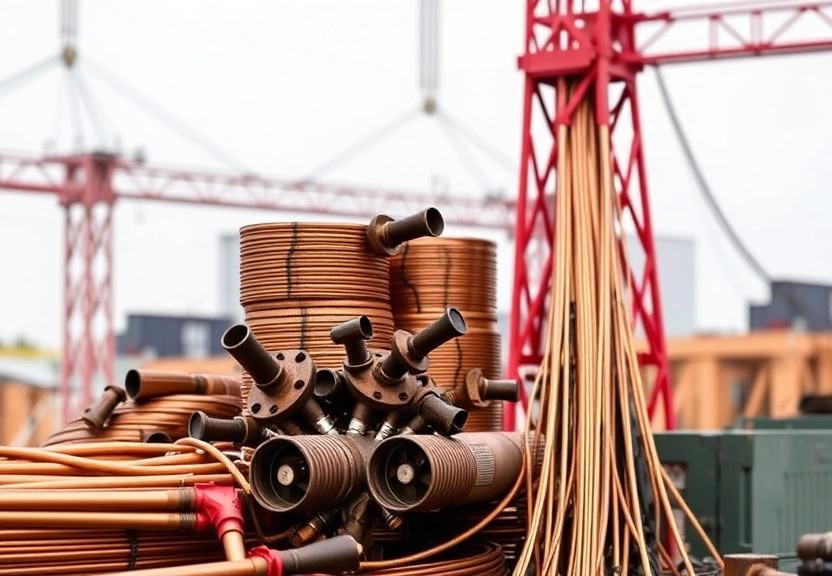Copper Tariffs: A Crucial Step for America’s Economy in the Face of China
The recent imposition of a 50% tariff on copper imports marks a significant shift in the United States’ trade policy, particularly in light of the ongoing competition with China. Copper, a fundamental metal used in various industries—from construction to electronics—plays a crucial role in the U.S. economy. With China being the largest producer and consumer of copper, this tariff represents not just a defensive maneuver but a strategic offensive aimed at reshaping the landscape of global trade.

As the U.S. grapples with its reliance on imports and confronts the challenges posed by China’s economic policies, the copper tariff serves as a pivotal first step towards a more robust economic strategy. However, to truly counter China’s dominance and strengthen the U.S. economy, further measures are needed. This article will delve into the implications of copper tariffs, their economic impact, and the necessary subsequent steps to bolster American economic resilience.
The Rationale Behind Copper Tariffs
The introduction of copper tariffs is rooted in a broader strategy to protect American industries and promote domestic production. By imposing tariffs, the U.S. government aims to discourage reliance on foreign copper, particularly from China, which has been accused of unfair trade practices, including subsidies and dumping.
Addressing Trade Imbalances
One of the primary reasons for implementing copper tariffs is to address the significant trade imbalance between the U.S. and China. In recent years, the U.S. has imported more copper than it has exported, leading to a growing deficit. By increasing the cost of imported copper, the tariffs encourage domestic production, which can help balance trade and reduce dependency on foreign sources.
Protecting Domestic Industries
American manufacturers, especially those in the construction and electrical sectors, have long struggled with the fluctuating prices of imported copper. The tariffs are designed to protect these industries by leveling the playing field against cheaper Chinese imports. With reduced competition from foreign producers, American companies can invest in expanding production and innovation.
Economic Impacts of the Tariff on U.S. Industries
The imposition of copper tariffs will have varied impacts on different sectors of the U.S. economy. While some industries may benefit, others may face challenges due to increased costs.
Positive Effects on Domestic Production
Higher tariffs on copper imports are expected to stimulate domestic production. This could lead to job creation in mining and manufacturing sectors, as companies ramp up operations to meet local demand. Furthermore, increased production can foster innovation, as businesses invest in new technologies and processes to enhance efficiency.
Challenges for Other Industries
Conversely, industries reliant on copper for production may experience increased costs. For example, the electrical and construction industries could face higher prices for materials, potentially leading to increased costs for consumers. Companies may have to adjust their pricing strategies or find alternative materials, which could affect profit margins and market competitiveness.
What’s Needed Next: A Comprehensive Economic Strategy
While copper tariffs are a critical first step, they should be part of a broader economic strategy aimed at countering China’s influence and strengthening the U.S. economy. Here are several key actions that should be considered:
- Investment in Domestic Mining: The U.S. should invest in domestic mining operations to increase local copper production, reducing reliance on imports.
- Support for Innovation: Encouraging research and development in copper alternatives and recycling can help mitigate the dependency on mined copper.
- Strengthening Supply Chains: Building resilient supply chains that reduce vulnerabilities to foreign disruptions will be crucial for economic stability.
- Trade Agreements: Pursuing fair trade agreements that promote American interests while holding other countries accountable for unfair practices is essential.
- Workforce Development: Investing in workforce training programs will ensure that American workers are equipped with the skills needed in a changing economy.
The Role of Diplomacy in Trade Relations
While tariffs can serve as a tool for economic protection, diplomacy remains crucial in navigating complex trade relations with China. Engaging in dialogue and negotiations can lead to more sustainable solutions that benefit both nations.
Negotiating Fair Trade Practices
The U.S. should prioritize negotiations with China to address unfair trade practices that have contributed to the trade imbalance. By establishing clear guidelines and consequences for violations, the U.S. can promote a more equitable trading environment.
Collaborating with Allies
Building coalitions with other nations facing similar challenges can amplify the U.S. position in trade discussions. Collaborative efforts can lead to stronger collective bargaining power and create a unified front against unfair practices.
FAQs About Copper Tariffs and Their Economic Impact
1. What are copper tariffs?
Copper tariffs are taxes imposed on imported copper to make foreign products more expensive and protect domestic producers.
2. How will copper tariffs impact the U.S. economy?
The tariffs are designed to stimulate domestic production, create jobs, and reduce reliance on imports, but they may also lead to higher costs for industries that rely on copper.
3. What industries will be most affected by copper tariffs?
Industries such as construction, electrical manufacturing, and plumbing will be significantly impacted due to their reliance on copper as a primary material.
4. Are there alternatives to using copper?
Yes, industries are exploring alternatives such as aluminum and recycled materials to mitigate the impact of rising copper prices.
5. How can the U.S. government support domestic copper production?
The government can support domestic production through investment in mining operations, incentives for innovation, and workforce development programs.
Conclusion
The introduction of a 50% tariff on copper imports is a crucial initial step for America’s economic strategy in the face of China’s dominance. While the tariffs may provide immediate relief to domestic producers, they must be part of a larger, comprehensive approach that includes investments in domestic production, innovation, and international diplomacy. By taking these steps, the U.S. can not only counter China’s influence but also strengthen its own economic resilience for the future. As the global landscape continues to evolve, the U.S. must remain vigilant and proactive in its trade policies to ensure long-term prosperity.
📰 Original Source
Este artigo foi baseado em informações de: https://www.marketwatch.com/story/trumps-copper-tariff-is-a-first-step-heres-whats-needed-now-to-counter-china-44a6a1db?mod=mw_rss_topstories


